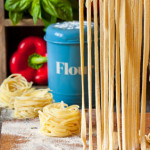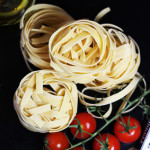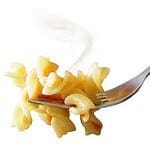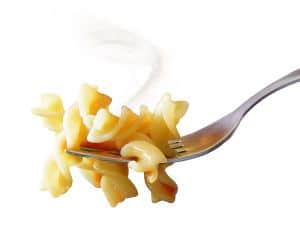There are a few pasta cooking rules that are important to memorize and you’ll have perfect pasta every time.
Boil your noodles in well-salted water, save that pasta liquid to make the glossiest pan sauce, do not rinse cooked pasta, and always pass extra grated parmesan cheese at the table.
“Work With What You Got!”
©Tiny New York Kitchen © 2019 All Rights Reserved
Cooking Pasta
There is no salt in pasta dough, so make sure to put enough salt in the cooking water. Use plenty of water, which should be about 4 quarts per 1 pound of pasta. Because salt actually slows down the rate at which water comes to a boil, add salt after the water is boiling. Use a heaping teaspoon for every quart of water. If you don’t think that you have enough salt in the water, then taste it, and you should be able to detect the salt.
I like to serve pasta from a warmed serving bowl. Place the bowl in the sink and set the colander inside of the bowl. Drain the pasta, letting the water drain into the bowl. Lift up the pasta in the colander, give it a good shake to drain further, and then pour the pasta into the still warm cooking pot. Make sure to NEVER rinse the pasta. This is a big no no. Then add the sauce to the pasta, in the cooking pot, and combine. Pour out the water from the serving bowl. I always reserve a cup or two of the pasta water in case I want to thin out the sauce a bit. Dry the bowl and transfer the pasta to the warm bowl and serve. It’s that easy.
“Work With What You Got!”
© Victoria Hart Glavin Tiny New York Kitchen © 2016 All Rights Reserved
Cooking Pasta
Delicious, healthy, and easy to prepare, pasta is the perfect food for the way we eat today. There have never been more enticing noodles to choose from. So whether you’re cooking fresh fettuccine, dried penne, or Asian pasta, here’s how to get great results every time.
Fresh, tender pasta is a delight to eat, but fresh pasta isn’t superior to dried. It is simply different. Fresh noodles, which are typical of the cooking of northern Italy, are finer textured and richer because they are made with eggs and pair best with delicate sauces. By contrast, dried pasta, favored by southern Italian cooks, which is made from flour and water, is more economical, lower in fat, and the best choice for robust, highly flavored sauces.
For the best taste and texture, buy dried pasta made from durum wheat or semolina flour. Semolina is more coarsely ground durum wheat. Good quality pasta will have a clear yellow color and feel hard and smooth. Stored in a cool, dry, dark place, dried pasta will keep up to 1 year. Whole wheat pasta will keep up to 6 months. Store commercially makes fresh pasta in the refrigerator according to package directions, which should be up to 1 week, or freeze up to 1 month. Storing pasta in a clear glass or plastic container on an open shelf or counter exposes it to light, which destroys riboflavin, a B vitamin and key nutrient in pasta. Instead, store pasta in an opaque container or in the cupboard. Buy pasta sold in cardboard cartons, which keep out the light.
The secrets of cooking the perfect pasta are easy. Start with plenty of water. Use at least 4 quarts of water for every pound of pasta. Add the pasta and salt after the water comes to a rapid boil. If the water stops boiling when you add the pasta, cover the pot just until the boil returns. Stir frequently. This ensures even cooking and prevents strands from clumping or sticking to the bottom of the pot. Check early and often for doneness. Cooking times on packages are guides not rules. Start checking for doneness early. You don’t want to overcook your pasta. Test the texture. Perfectly cooked pasta should feel firm to the bite. This texture is described in Italian as al dente, or “to the tooth.” At this stage, the pasta will have no raw flour taste, but will reveal a tiny chalky white center. Residual heat will continue to cook the pasta as it’s drained and tossed, so gauge cooking time accordingly. Avoid a soggy sauce! Drain cooked pasta thoroughly by shaking excess moisture through the colander. NEVER rinse pasta! I like to drizzle a small amount of olive oil on the pasta after shaking the excess moisture through the colander. Serve pasta hot. Remember that pasta will wait for no one! The noodles tend to absorb liquid and the pasta will cool down quickly. For best results call everyone to the table while you are tossing and serve the pasta in prewarmed bowls.
Confused about salting the water? Almost all pasta recipes suggest adding salt to the pasta’s cooking water. Purists wouldn’t have it any other way. Some people shy away from this step because they’re worried about sodium, but in truth, the salt added to the water isn’t all absorbed by the noodles. It merely seasons the noodles and raises the cooking temperature 2 degrees. I recommend 2 teaspoons per pound of pasta. When you drain the noodles, you’re draining much of the sodium as well. Only about 10 percent is absorbed by the pasta. Salting the water results in pasta noodles with a much fuller flavor.
When cooking long pasta, like spaghetti or linguine, add the pasta to boiling water. Push the ends down as they soften until all of the strands are immersed. Cover the pot until the water returns to a boil. To prevent the noodles from sticking to the bottom of the pot, stir often. A spaghetti for grips and separates the strands, allowing for easier draining and neater serving.
Whatever pasta dish you are making for your family tonight you will have better results by following these tips. Manga!









